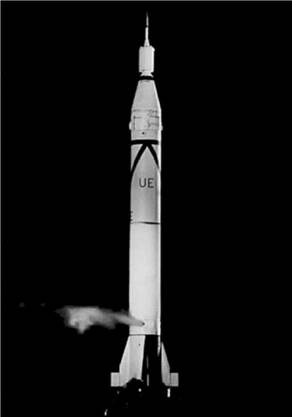OPENING SPACE RESEARCH
and rapidly playing back the data from a full satellite orbit in order to obtain comprehensive geographical and temporal coverage of the counting rate of the Geiger tube.
At the outset of the IGY, the planned vehicle for launching satellites was a Vanguard, under development by the Naval Research Laboratory and the Glenn L. Martin Company. I followed its development closely and also maintained contact with Ernst Stuhlinger of the Army Ballistic Missile Agency (ABMA) on a technically competitive but unofficial plan for a multistage ABMA/Jet Propulsion Laboratory (JPL) vehicle. Because of my progressive uneasiness about the difficulties in developing the Vanguard vehicle, Ludwig and I decided that the Iowa instruments would be designed for compatibility with either the Vanguard or the ABMA vehicle, later called Jupiter C.
All of our preparatory work culminated in the late autumn of 1957 following success of the Soviet Sputniks 1 and 2, early failures of the Vanguard vehicle, and the consequent national decision to adopt the Jupiter C as a backup vehicle. JPL was assigned overall responsibility for the payload, and the U. S. IGY staff chose the Iowa package as the primary scientific instrument thereof.
In mid-November 1957, Ludwig drove his family from Iowa City to Pasadena, California, with his precious instrumentation in the trunk of their personal automobile in order to work with the JPL staff in integrating it into the payload of the Jupiter C.
The successful launch of Explorer I on 31 January 1958 and Explorer III on 26 March 1958 placed our radiation instruments in space. After several weeks of intense puzzlement in understanding our data, my colleagues and I recognized that we had discovered the presence of an enormous population of energetic, electrically charged particles trapped in the external magnetic field of the Earth—later called the radiation belts. The in-flight reliability of Ludwig’s instruments was central to this discovery.
Ludwig continued at the University of Iowa with the development of radiation instruments for subsequent satellite flights and later had a distinguished career as a senior official of the National Aeronautics and Space Administration and the National Oceanic and Atmospheric Administration.
James A. Van Allen University of Iowa October 2004
|
FIGURE 0.1 The diminutive Explorer I sitting atop its Jupiter-C launch vehicle just moments before lift-off. The first stage liquid oxygen tank is frosted and still venting, and the upper-stage cylindrical tub and pencil-like satellite are spinning. (Courtesy of the NASA Marshall Space Flight Center.) |
Prologue











